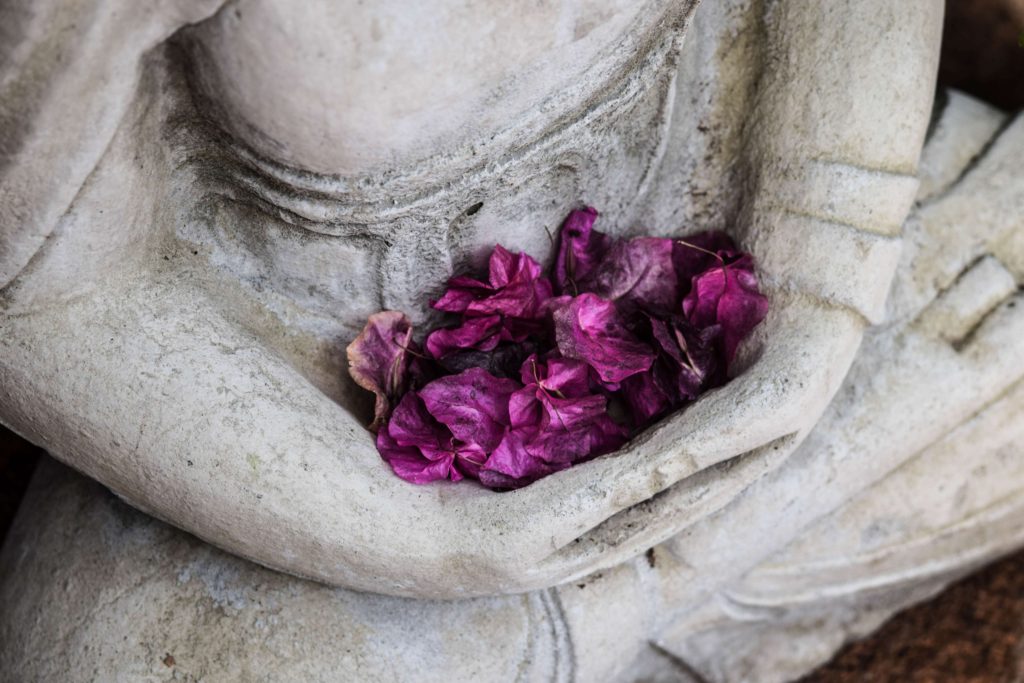
BEING, FEELING, KNOWING, DOING – A Wholistic 4-Part Meditation for Busy People
This article, a guest post from Eric Santagada, outlines a four-part meditation that combines ancient Indian wisdom with modern science, in a way that is simple and comprehensive. It can be done in as little as 5 minutes, or can be stretched out to an hour or more. I do this first thing every morning, for 20-40 minutes. I learned the basic structure from the great Deepak Chopra.
Everyone is talking about meditation. From CEOs to linebackers, from doctors to surf bums, the word is out – meditation is the simplest and most effective way to increase the quality of our lives.
The benefits of meditation are enormous and well-documented. Check out this article for more information on the benefits of meditation:
https://www.huffingtonpost.com/2014/09/19/meditation-benefits_n_5842870.html
The biggest obstacle is often finding an appropriate meditation style. There are countless methods from many teachers and traditions across the world. Strive to find a practice that you understand and enjoy. Also, be sure to practice every day, if only for a few minutes. Meditation works best when adopted as a daily practice, even if just for a few minutes. A consistent 5-minute practice is oftentimes more useful than sporadic hour-long sittings. All too often, one day off leads to never practicing again.
The four basic experiences we will move through are BEING, FEELING, KNOWING, and DOING. Each of these is a distinct layer of human consciousness. By deliberately working on each, we can activate every part of our brain, body, and nervous system, developing a balanced whole.
(Side Note: These correspond to the four yoga paths of Raja, Bhakti, Jnana, and Karma.)
Stay In Touch With Being Zen
PART ONE – BEING
The first experience is BEING. This part of the meditation is simple, but not always easy. We will quiet the mind and focus on our breathing, remaining as present in the moment as possible.
IN PRACTICE
Come to a comfortable seated position, on a cushion with legs crossed, or if sitting on a chair, with feet on the floor. Avoid noisy and distracting places, if possible.
Make sure you are sitting straight and tall, spine in alignment over hips, head over spine. Relax as much as you can while holding good postural alignment. You are aiming for a state of restful awareness.
And now, simply breathe. Do not manipulate the breath, just watch it. Observe the breath moving through the body – in and out of the nostrils, into the belly and chest.
When your thoughts begin to wander, as they will, gently bring your attention back to the breath, over and over. If you are distracted by thoughts, sounds, sensations in the body, etc – come back to the breath. Try not to judge your thoughts, just watch them come and go. Spend 1-10 minutes in this quiet space.
https://beingzen.com/finding-a-meditation-routine/
IN THEORY
By observing the breath in this way, we remain present in the NOW moment, and the mind eventually becomes still and clear. At this point, the brain waves slow down and come into a harmonious theta state*. We are tapping into the deepest recesses of our brain.
When we are still like this, the body’s self-repair mechanisms kick in – such is the regenerative nature of the human body. After a few minutes of BEING, we are now ready to move on to the second stage.
*Read more about the different brain wave states here: https://www.thetahealing.com/about-thetahealing/thetahealing-theta-state.html
PART TWO – FEELING
The second phase is FEELING. We now consciously evoke the distinct positive feelings of Love, Compassion, Joy, and Peace, one after another. These four emotions are recommended by the greatest teachers of all traditions. You can add other positive emotions if you like.

IN PRACTICE
Begin by bringing attention to your heart.
Now think of someone you love. Think about the things you love about this person. See their smiling face. Spend a few moments in this loving awareness.
Now think of someone you know who is in pain and suffering. Feel their pain. Have the desire that they get better. Spend a few moments in this compassionate space. This practice of feeling is similar to “Loving Kindness” or “Meta” meditation. Tara Brach is one of my favorite meditation teachers and authors, and she has some fantastic guided meditations in this style.
Now think of an experience that brings you great joy. Something in the past, or coming in the future, that makes a smile bubble to your lips. Spend some time in this sweet enjoyment.
Now enter into a feeling of great peace. You may use an image such as a sunset, or a Buddha in meditation, or a radiant Jesus, or simply listening to the deep silence within. Hear the word in your mind – Peace. Spend some time here.
Stay In Touch With Being Zen
IN THEORY
Emotions activate the limbic system in the brain and body, our emotional center. The limbic system is a part of our mammalian brain, crucial in developing social skills and emotional intelligence. By creating and truly feeling these emotions from within, we are strengthening these “muscles,” making it easier for us to use them during our daily life.
Feelings are often called the secret of manifestation. When we choose to feel positive emotions in the body, it is effortless to attract positive situations in our daily lives. To those who understand, this is a jewel of the deepest wisdom.
We are now ready to move into the third part of this meditation – KNOWING.
PART THREE – KNOWING (OR UNDERSTANDING)
The third phase of this meditation is KNOWING. By asking ourselves the deepest and simplest questions of life, we activate and strengthen our prefrontal cortex, the “human” part of the brain. Here lies self-awareness, inspiration, creativity, reflection, and intuition. The four questions are:
- Who am I?
- What do I want?
- What is my purpose?
- What am I grateful for?
IN PRACTICE
Bring your attention to your heart.
- Ask your heart, “Who am I?” several times. Do not consciously answer the question, but listen for the answer from your heart.
- Next, ask your heart, “What do I want?” several times. Listen for an answer.
- After a minute or so, ask your heart, “What is my purpose?” Listen for the answer.
- Lastly, ask your heart, “What am I grateful for?” Listen for the answer.
Sit quietly while you process these questions. You may want to have a journal nearby to record any inspired revelations.
IN THEORY
This portion of the meditation activates our prefrontal cortex, the imaginative, creative, thinking part of our brain. Thinking is essentially a process of asking and answering questions in our mind. These four simple questions are deceptively deep, cutting to the heart of our existence. They are the foundation of understanding oneself and one’s place in the world.
(The great Indian Sage Ramana Maharshi believed that the first question alone, “Who Am I?”, if persistently asked, can lead one to enlightenment. You will find similar questions or mantras in many different traditions, such as the Kwan Um School of Zen).
We are not ready to move to the final part of this meditation – DOING.
PART FOUR – DOING
The final phase of this meditation is DOING. We now consciously control our body and the world around us through our minds. This is the culmination of spiritual work, “the word made flesh.”
By moving from the most subtle, BEING, to the most gross, DOING, we complete the process and are ready to act in the world. We have tuned our mind, body, and soul like a master musician tunes their instrument.

IN PRACTICE
Bring your attention back to your breath. Tell your breath, “Slow Down” several times, and witness your breath slowing down.
Now move your attention to your heartbeat. You should be able to feel it as a sound, or a sensation in the body. (If you can’t at first, keep at it, eventually you will. You can place your finger on your wrist or neck pulse if you like.) Tell your heart, “Slow Down” several times, and witness it slowing down.
Now, bring your awareness to your fingertips. Feel the tingling, throbbing pulse in your fingertips for a few moments. Then scan the entire body, moving awareness from the feet all the way up to the crown of the head. If there is any particular place that requires healing, spend more time there – Awareness itself is healing.
End by inhaling deeply and making the sound OM, anywhere from one to 21 times. It is a smooth, long sound with three parts, pronounced A-U-M, or Ahhh-ohhhhh-mmmm.
After the sound OM, spend a few moments in quietude, absorbing the benefits of your practice. When you feel ready, open your eyes, and slowly move into the rest of your day. This is also a great time to incorporate a singing bowl into your practice!
IN THEORY
By exercising control over our heartbeat and breathing, we become true masters of our bodies. We are no longer at the whim of our base desires, but can wisely overrule them.
By scanning throughout our body, we increase circulation and come to understand the current state of our body better. We learn to listen when our bodies have something important to tell us. Awareness of the spine and chakra centers* is particularly helpful.
The sound OM, and other mantras, have incredible benefits. They bring us into the present moment, allow vast amounts of energy to flow freely, bring our mind to rarefied states, strengthen our will, and literally increase our physical vibration to a higher level. In the Vedanta tradition, OM is the most sacred syllable of all, being described as the primordial sound of all creation.
*More on Chakras here – https://chopra.com/articles/what-is-a-chakra

CONCLUSION
In the end, all of this comes from within yourself. The path to healing and wholeness is a journey of awareness. Everything you need is already inside of you. You simply must become aware of it.
This whole meditation experience can be done in five minutes, or stretched to over an hour. You can even take bits and pieces to practice throughout the day. You might notice the benefits accrue slowly and surely when you practice earnestly, every day, over a long period of uninterrupted time. But the practice itself is the benefit. We practice not with a goal in mind, but with an openness and willingness to learn about ourselves.
Please leave a comment, and let us know about your own meditation experiences. Good Luck!
-Eric Santagada
The Daily Remembrances: 5 Things To Remember Every Day According to The Buddha
Stay In Touch With Being Zen
Photo credits: